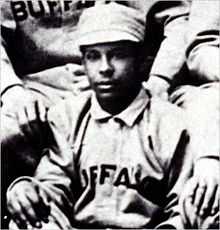Frank Grant
| Frank Grant | |
|---|---|
 | |
| Second baseman | |
|
Born: August 1, 1865 Pittsfield, Massachusetts | |
|
Died: May 27, 1937 (aged 71) New York, New York | |
| Batted: Right | Threw: Right |
| Professional debut | |
| Negro Leagues: 1889 for the Cuban Giants | |
| Last professional appearance | |
| 1903 for the Philadelphia Giants | |
| Teams | |
| |
Member of the National
| |
| Inducted | 2006 |
Ulysses Franklin "Frank" Grant (August 1, 1865 - May 27, 1937) was an African-American baseball player in the 19th century. Early in his career, he was a star player in the International League, shortly before Jim Crow restrictions were imposed that banned African-American players from organized baseball.
He became a pioneer in the early Negro leagues, starring for several of the top African-American teams of the late 19th and early 20th centuries. He is widely considered to have been the greatest African-American player of the 19th century. In 2006, Grant was elected to the National Baseball Hall of Fame. He is the earliest Negro league player to have received that honor.
Career
Grant was born in Pittsfield, Massachusetts. In the late 19th century, few black hitters matched up with Grant. However, two pitchers could be argued to have been the greatest players of their era - Newark's George Stovey and Syracuse's Robert Higgins.
A middle infielder, mostly a second baseman, Grant had fielding skills widely praised as the best in the league. When he joined Buffalo of the International League (IL) in the 1880s, some believed he was the best player they had ever had. He had been preceded by future Hall of Famers.
Grant had substantial power at the plate, often hitting home runs and very often getting extra base hits. Grant hit for extra bases every four times he got a hit. He achieved this although he was quite small (5'7", 155 pounds). He also hit .344 with Buffalo.
Playing mostly second base, he was frequently among the league leaders in batting (1886 - 7th, .326; 1886 - 3rd, .340; 1888 - 5th, .346; 1890 - 5th, .328). In 1887, the 22-year-old paced the IL with 11 home runs and 49 extra-base hits and led Buffalo with 40 stolen bases. Grant also earned the nickname the "Colored Dunlap" in honor of the white Fred Dunlap, the major leagues' slickest fielding second baseman at the time.
He repeatedly impressed the white baseball establishment. In 1887, John Chapman, the Bisons' veteran manager, valued Grant's services at $5,000—quite a compliment when Chicago had recently sold superstar Mike Kelly to Boston for $10,000. During the 1887 season, he hit for the cycle in one game and stole home twice in another. Despite significant racial turmoil that year, Buffalo forced the IL to rescind a proposed color line to keep Grant in town.
Grant is also notable for becoming the first black player to play on the same team in organized baseball for three consecutive seasons.
By 1888, anti-black sentiment was all around the league, and it seemed only Buffalo argued against segregation (possibly because of Grant). When blacks were banned from organized, white-controlled baseball after 1887, Grant went on to become a hugely successful Negro Leaguer for the Cuban X Giants, Big Gorhams and Philadelphia Giants into the 20th century.
Grant ended his career in 1903, ending the early era of the Negro Leagues. From there, the Negro leagues would blossom and expand into the mid-1940s. They likely never would have done so without the early players such as Grant.
He died at age 71 in New York City. His grave in East Ridgelawn Cemetery, Clifton, New Jersey, was unmarked until June 2011.
See also
References
- Pennington, Bill (July 27, 2006). "Breaking a Barrier 60 Years Before Robinson". New York Times. Retrieved 2008-08-10.
- Riley, James A. (1994). "Grant, Ulysses F. (Frank)". The Biographical Encyclopedia of the Negro Baseball Leagues. Carroll & Graf. pp. 331–32. ISBN 0-7867-0959-6.
- (Riley.) Frank Grant, Personal profiles at Negro Leagues Baseball Museum. – identical to Riley (confirmed 2010-04-16)
- Yellin, Deena (June 15, 2011). "Gravesite of Negro Leagues pioneer finally gets marker". The Record. Retrieved 2011-07-26.
- ↑ "Genuine Cuban Giants", The Evening Times, Washington, DC, 23 May 1896, p. 3
- ↑ "Giants Were Twice Defeated", The Patriot, Harrisburg, Pennsylvania, September 11, 1903, p. 7
External links
- Frank Grant at the Baseball Hall of Fame
- Career statistics and player information from Baseball-Reference (Minors)
- 2006 Hall of Fame Inductee Bio: Frank Grant (video) – unknown content, URL confirmed 2010-04-16
| |||||||||||||||||
| |||||